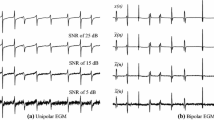Abstract
Short-term properties of atrial fibrillation (AF) frequency, f-wave morphology, and irregularity parameters have been thoroughly studied, but not long-term properties. In the present work, f-wave morphology is characterized by principal component analysis, introducing a novel temporal parameter defined by the cumulative normalized variance of the three largest principal components \((r_3)\). Based on 7-day recordings from nine patients with stable chronic heart failure and persistent AF, long-term properties were studied in terms of \(r_3\), AF frequency, and sample entropy \((SampEn)\). The main result of the present study is that detection of circadian rhythms depends on the parameter considered: rhythms were found in six \((r_3, SampEn)\) and five (AF frequency) patients, but not always in the same patient. Another important result is that circadian rhythms detected in 7-day recordings could not always be detected in 24-h periods, thus shedding new light on the results in previous studies which all were based on 24-h recordings. Infradian rhythms were found in four \((r_3, SampEn)\) and one (AF frequency) patients.




Similar content being viewed by others
References
Alcaraz R, Rieta JJ (2009) Sample entropy of the main atrial wave predicts spontaneous termination of paroxysmal atrial fibrillation. Med Eng Phys 31(8):917–922
Alcaraz R, Rieta JJ (2010) A review on sample entropy applications for the non-invasive analysis of atrial fibrillation electrocardiograms. Biomed Signal Proc Control 5(1):1–14
Bingham C, Arbogast B, Guillaume GC, Lee JK, Halberg F (1982) Inferential statistical methods for estimating and comparing cosinor parameters. Chronobiologia 9:397–439
Bollmann A, Husser D, Mainardi L, Lombardi F, Langley P, Murray A, Rieta JJ, Millet J, Olsson SB, Stridh M, Sörnmo L (2006) Analysis of surface electrocardiograms in atrial fibrillation: techniques, research, and clinical applications. Europace 8(11):911–926
Bollmann A, Kanuru NK, McTeague KK, Walter PF, DeLurgio DB, Langberg J (1998) Frequency analysis of human atrial fibrillation using the surface electrocardiogram and its response to ibutilide. Am J Cardiol 81:1439–1445
Bollmann A, Sonne K, Esperer HD, Toepffer I, Klein HU (2000) Circadian variations in atrial fibrillatory frequency in persistent human atrial fibrillation. PACE 23(11):1867–1871
Bonizzi P, Guillem MS, Climent AM, Millet J, Zarzoso V, Castells F, Meste O (2010) Noninvasive assessment of the complexity and stationarity of the atrial wavefront patterns during atrial fibrillation. IEEE Trans Biomed Eng 57(9):2147–2157
Efron B, Tibshirani RJ (1993) An introduction to the bootstrap. Chapman & Hall, Boca Raton
Faes L, Nollo G, Kirchner M, Olivetti E, Gaita F, Riccardi R, Antolini R (2001) Principal component analysis and cluster analysis for measuring the local organisation of human atrial fibrillation. Med Biol Eng Comput 39:656–663
Goya-Esteban R, Mora-Jiménez I, Rojo-Alvarez JL, Barquero-Pérez O, Pastor-Pérez FJ, Manzano-Fernández S, Pascual-Figal DA, García-Alberola A (2010) Heart rate variability on 7-day holter monitoring using a bootstrap rhythmometric procedure. IEEE Trans Biomed Eng 57(6):1366–1376
Holm M, Pehrsson S, Ingemansson M, Sörnmo L, Johansson R, Sandhall L, Sunemark M, Smideberg B, Olsson C, Olsson SB (1998) Non-invasive assessment of atrial refractoriness during atrial fibrillation in man: introducing, validating, and illustrating a new ECG method. Cardiovasc Res 38:69–81
Joliffe IT (2002) Principal component analysis. Springer, Berlin
Mainardi L, Sörnmo L, Cerutti S (2009) Understanding atrial fibrillation: the signal processing contribution. Morgan & Claypool, San Francisco
Meurling C, Waktare J, Holmqvist F, Hedman A, Camm A, Olsson SB, Malik M (2001) Diurnal variations of the dominant cycle length of chronic atrial fibrillation. Am J Physiol 280:H401–H406
Nilsson F, Stridh M, Bollmann A, Sörnmo L (2006) Predicting spontaneous termination of atrial fibrillation using the surface ECG. Med Eng Phys 28(8):802–808
Richman JS, Moorman JR (2000) Physiological time-series analysis using approximate entropy and sample entropy. Am J Physiol Heart Circ Physiol 278(6):2039–2049
Sandberg F, Bollmann A, Husser D, Stridh M, Sörnmo L (2010) Circadian variation in dominant atrial fibrillation frequency in persistent atrial fibrillation. Physiol Meas 31:531–542
Sandberg F, Stridh M, Sörnmo L (2008) Frequency tracking of atrial fibrillation using hidden Markov models. IEEE Trans Biomed Eng 55:502–511
Stridh M, Husser D, Bollmann A, Sörnmo L (2009) Waveform characterization of atrial fibrillation using phase information. IEEE Trans Biomed Eng 56(5):1081–1089
Stridh M, Sörnmo L (2001) Spatiotemporal QRST cancellation techniques for analysis of ftrial fibrillation. IEEE Trans Biomed Eng 48(1):105–111
Acknowledgments
This work has been partially supported by Research Projects from the Spanish Goverment TEC2010-19263 and TEC2013-48439-C4-1-R, and by the Prometeo Project of the Secretariat for the Higher Education, Science, Technology and Innovation of the Republic of Ecuador. Oscar Barquero-Pérez is supported by FPU grant AP2009-1726.
Author information
Authors and Affiliations
Corresponding author
Rights and permissions
About this article
Cite this article
Goya-Esteban, R., Sandberg, F., Barquero-Pérez, Ó. et al. Long-term characterization of persistent atrial fibrillation: wave morphology, frequency, and irregularity analysis. Med Biol Eng Comput 52, 1053–1060 (2014). https://doi.org/10.1007/s11517-014-1199-x
Received:
Accepted:
Published:
Issue Date:
DOI: https://doi.org/10.1007/s11517-014-1199-x




